In Pursuit of North Dakota’s Upland Smorgasbord
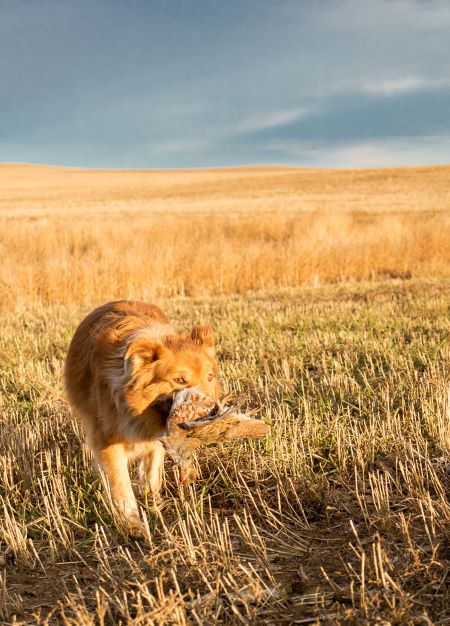
October 23rd. Morning dawned bright, clear, and crisp in western North Dakota as I fumbled through a storage box in the bed of my beaten, old two-wheel-drive Ford Ranger pick-up. It’s not much to look at, but it carries a lot for little gas money, getting me to places I love to visit. Out amongst frosted sunflowers a rooster crowed, not the barnyard variety. My pulse quickened. Somewhere further, another chimed in as if to remind the first he was still there too. Their banter reminded me of why I love this place so much. Yep, I was home, even if I don’t actually reside here.
Necessary items came out of the storage box, important miscellany such as ammunition, water bottles and the like. After dropping a fresh pair of 5’s in the double I sent my faithful bird finder, Rusty, forth into the mix of stunted sunflowers and kochia. Heaven knows recent drought hasn’t been kind to my friend Scott’s farm, but at least we got a good rooster patch until the combine did its best to harvest what it could, causing most of the pheasants to move into the neighbor’s unharvested ground.
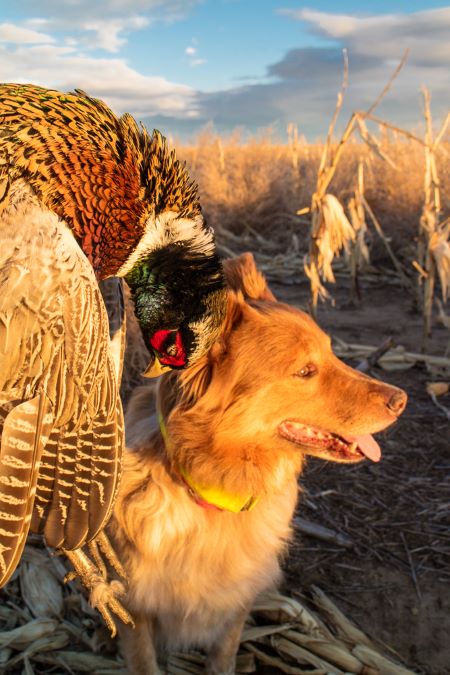 The author’s dog Rusty with one of the many pheasants taken on his North Dakota hunt.
The author’s dog Rusty with one of the many pheasants taken on his North Dakota hunt.Scott’s son and a friend hunted here a week earlier. Their glowing recount proved a welcome change from gloomy reports of low pheasant numbers, a situation now in year number four. It only made sense to start my month long stay here. Immense tracts of public and PLOTS (Private Land Open to Sportsman) land could wait until later. A month? Seriously? Now you know why I consider the place my second home. Sure, I had work to do while here on the farm, but each day held plenty of time to hunt. Right now my only job was to keep up with the dog and running roosters.
Run they did, for a pheasant likes nothing better than to stay low and evade pursuit when pressed. But they will hunker in if they think they can get away with it, an instinct encouraged by scattered strips of kochia weed. Rusty and I pushed birds toward these fortresses as best we could. Soon, wiser birds began busting loose. To disrupt this growing exodus I bolted forward and found myself in the catbird seat with dog charging around me, pheasant wings churning left and right. Go time!
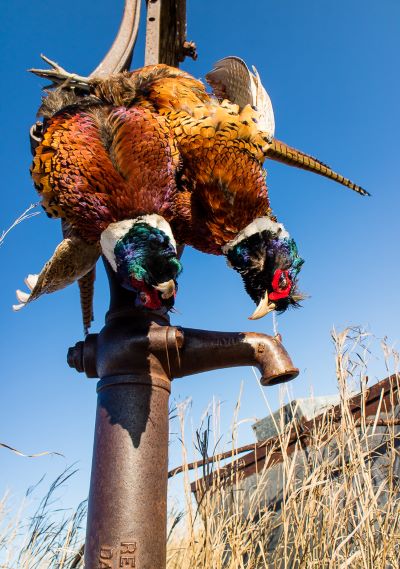 Two more pheasants that went into the bag.
Two more pheasants that went into the bag.Two birds down. Now comes the tough part. A pheasant in armpit-deep kochia can pose great difficulty. The first rooster, stone dead, presented little challenge for Rusty, however, the one I winged would. It’s an awful lot to ask a dog to find a running bird in a sea of fresh bird scent, yet they seem to manage. I believe they use their ears as much as their nose in this situation, even if I can’t prove it scientifically.
As Rusty returned with the dead bird I rushed to meet him halfway to hasten the chase for our runner. Chase indeed. We were off to the races; Rusty finally catching the fugitive bird along the weed choked south fenceline. Of course, other pheasants in there figured their neighborhood had gone sour and set wings to air. I missed a colorful fence jumper, both barrels.
No matter, Rusty now gripped our still-kicking escapee in his jaws. I fumbled the hand-off, giving the tenacious rooster another shot at freedom, a short lived phenomenon that bought more fence birds precious seconds to evacuate while I tended to the business at hand. Dispatched bird now in bag, we headed off in hopes of downing one more.
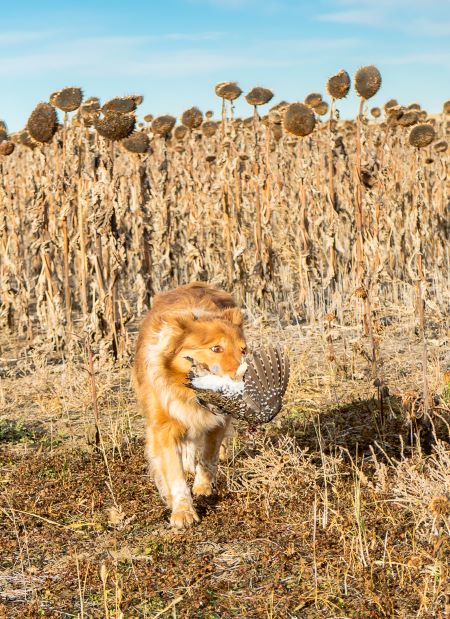 The author’s dog rusty fetched a sharptail from the sunflowers.
The author’s dog rusty fetched a sharptail from the sunflowers.Pheasant for lunch made a nice interlude prior to an afternoon sharptail grouse hunt. The nearest PLOTS land proved a near dud, but we managed to find and grass a lone grouse. Word was grouse numbers were on the upswing yet again. This chunk of ground did nothing to reinforce the notion.
The following day I found what I hoped for, a great many grouse in rolling badlands to the west. Sharptails are not known for holding well come mid-season, but enough did. They sit tighter during warm weather and this magnificent T-shirt day with mild breezes sure helped. By week’s end I would lean hard into a 65-miles-per-hour blow and test my ability to catch Mach-1 birds with gun barrels. For now, I reveled in a soft glowing sun before driving 45 minutes back to Scott’s farm. After lunch I would learn the irony of my windshield time, flushing hundreds of grouse while chasing a few wised up pheasants on public land only a few miles from camp.
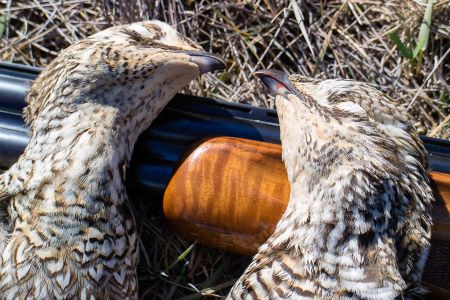 A sharptail double taken by the author.
A sharptail double taken by the author.These are the golden days I remember. Back when I began these pilgrimages, pheasants were ample, but a scant fraction of what populations would rise to during the glory days of the early 2000s. Now come full circle, I’m okay with it. I like the return to calmer times and better grouse numbers. Things just got too darn busy when the blue head birds topped record tallies. Today, most hunters have found someplace new with more birds. Me? I just like being “home.”
Unfortunately the Hungarian partridge remain tough to come by. Southwest North Dakota was never famous for them like the Border country up north, but I used to get the “Nodak nine” somewhat often 20 years ago. Nodak nine? Three roosters, three sharptails, and three huns. Today, it’s a season highlight, if it happens at all.
Two weeks of hunting produced minimal partridge contact. I largely gave up hope of pulling it off. Then one day a rather large covey of huns erupted beyond range as I sauntered along carrying a trio of grouse. I posed no immediate threat as they set wings for some unknown location. Switching to handloads of #7 I plotted a new course, placing faith in Rusty to eventually alert me of their presence.
 A pair of huns taken with the author’s Cogswell & Harrison.
A pair of huns taken with the author’s Cogswell & Harrison.Huns can be easy or difficult to relocate, depending on how long they remain visible. These sailed over a distant rise, leading me to believe they would settle near the only brush patch. I was wrong, however, and time to search was a plenty. We burned an hour of it, but oh my what reward. The gray birds held blissfully tight this time, offering an outstanding chance at a double. Right, then left barrels spoke: two huns succumbed to gravity. Doesn’t always happen that way, so I cherish the moment when it does. The remainder of the covey cut in hard against a high grassy bank where my approach could go undetected. A gift! Seldom do these well-organized fowl make a mistake of such a grand scale. I saw their eyes clearly when they boiled up underfoot during our final dance.
In the following days more hun discoveries delighted me in places I didn’t expect. One place, I should have expected since I have shot partridges there during past years. Most hun occupancy on this public ground ended about time it turned popular, yet this portion hosts one tenacious group, hardy little birds that refuse to surrender. They surprised me adjacent to another patch of sunflowers. Pheasants adore sunflowers, sharptails get plumb addicted to them. Huns? It must be like swallowing a football for such small birds, but they do it and I caught them on their way to breakfast one morning. I believe they startled me more than I did them. Number 5 shot is a lousy choice for small birds, pattern’s too course. I shot anyway, hoping for a golden BB, receiving none. All I can say is halleluiah for the reflush when the gun’s chambers carried smaller shot.
 North Dakota’s prairie high winds would whip through the decoys.
North Dakota’s prairie high winds would whip through the decoys.It’s funny how huns can be someplace and go unnoticed like that. Another spot, a newly found favorite for sharpies, hid a large covey of the little gray birds in addition to a surprisingly reliable band of grouse. I hunted that chunk of PLOTS half a dozen times before running into the partridges. Time of day is likely responsible as this was the first time I hunted it early in the morning. Rusty hit scent hard only 50 yards from the truck. Seems the little guys were graveling prior to my arrival and set to scrambling through the CRP as my truck approached. Rusty’s pace and intensity indicated runners. Pheasants? Unlikely, since the place had yet to show us a single rooster. It didn’t matter, he had hot scent and I would gladly start the day with whatever legal game bird erupted. A single launched close by. I took that bird clean, providing an easy retrieve for my little buddy. A single? So much scent and only one bird?! Rusty acted as though a legion were present. I took three steps and the world exploded. At least 20 feathered bombshells tore through a leaden dawn sky. My light 12 leapt to shoulder and two more put a feathered grin on my dog.
Dreams of a Nodak nine alive and well, we headed onward for grouse, sharptails kind enough to actually be where we looked when we looked there. My shooting deteriorated dismally. Thankfully I carried enough shells to keep trying until settling back into a rhythm. The thought of going “nine” distracted me a bit. Seldom do days play out like a dream, but this one did, complete with roosters along a cattail slough. I doubt I shall forget it anytime soon.
Another event etched in memory is a morning goose hunt. Southwest North Dakota will never make the list of “must do” locations for waterfowlers, there just aren’t that many birds compared to regions further east. I seldom see another goose hunter. Still, sometimes a field may gather 500-plus geese during migration and this is the situation I found. Better yet, the field belonged to another friend who usually hunts geese with me. Not a bad scenario. He was unable to hunt geese this particular morning, but promised to meet me later for pheasants.
The setup was ideal. Large numbers of Canadas and a few flocks of specklebellies assembled in a harvested cornfield, now sprouted in winter wheat. A small wash through the field ran across the tip of an adjacent field where corn was later picked a little rough along the edge and interspersed with a few tumbleweeds. Most importantly, geese had been using this location recently. This made for a mighty fine place to lay in a ghillie suit. I prefer ghillies to layout blinds for two reasons: instant mobility if wind changes and they don’t show an unnatural linear shadow like a blind with a frame will. Geese can spot that shadow real well, especially on sunny days.
 The author with a North Dakota goose bounty.
The author with a North Dakota goose bounty.Setting up in the dark involved placing five-dozen feeders in scattered family groups with only one or two sentries mixed in. This tells circling geese all is well and food is aplenty. Slightly downwind of the largest cluster (represents feeding hotspot) I placed a group of three sentries to represent new arrivals walking in to join the crew. I call it the “landing party.” Quite often, incoming geese will land right by these and it is all arranged so as to put geese on an ideal approach.
Stout winds under a leaden sky quickly whisked away sweat I earned placing decoys. I dropped my blind bag along the tumbleweeds then quickly drove the Ranger to a shelterbelt a half-mile distant so it wouldn’t spook geese. I donned ghillies, grabbed gun and a few more shells, and then hustled toward the spread. Geese on the lake grew far too noisy for my comfort. As feared, three early flocks beat me to the spread. I was inline with the fourth and took advantage of the ghillie suit; two birds went down hard.
Goose activity reached a fever pitch soon after my arrival at the tumbleweeds and kept me mighty busy for a short while. North Dakota is very generous with goose limits outside the Missouri River zone, in less than 20 minutes eight honkers and three specks were down. Wow! I’ve experienced some heart racing goose hunts, but this was crazy.
My buddy arrived as I picked up dekes. He and I both enjoyed a repeat performance with geese a week later. For now, off to a milo field for pheasants followed up with grouse in the short grass. What else could a hunter want? Well there is the matter of mallards, teal, and a pair of wood ducks, but that’s a story for another day. The North Dakota smorgasbord can fill anyone’s plate. Maybe a month isn’t enough? Heaven knows I’ve considered moving there. After all, it does feel like home.
Garhart Stephenson is an avid outdoorsman residing in west central Wyoming. Throughout the year he is typically outdoors with rod or gun in the company of his faithful Border Collie, Rusty.

Garhart Stephenson is an avid outdoorsman residing in west central Wyoming. Throughout the year he is typically outdoors with rod or gun in the company of his faithful Border Collie, Rusty.


Comments